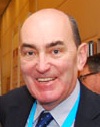At EDI CON China 2016 Thomas W. Crowe, President of Virginia Diodes Inc. gave Microwave Journal an insight into the company’s background, its focus on very high frequencies, its current activities in China and future technology developments.
Offering a brief explanation of the company’s background Crowe began, “I started the company in 1996 with a colleague when I was a professor at the University of Virginia. We had developed this really great diode technology, so we negotiated to set up the company and license the technology. We used the university facilities for the first five or six years.”
He continued, “In 2001 we started getting SBIR [Small Business Innovation Research] contracts in the US. So, we recruited two of my former PhD students as principals and then VDI really started to grow into a full-time business. By 2004 I was tapering down my time in the university, and left completely in 2005. Around that time we built our own facility with a clean room, and now employ about 70 people.”
When asked about what VDI was showcasing at EDI CON 2016 he admitted, “We can’t conveniently show much because of licensing issues. However, our heritage is high frequency, so in the booth we have a 200 GHz source with about 100 mW of output power. Overall, it is a good demonstration of several technologies. It illustrates the frequency synthesizer we developed to drive our sources, the amplifier multiplier chain, which increases the frequency of the synthesizer and also a power meter. It works over nearly the full frequency range of our sources, from about 70 GHz to over 3 THz.”
Elaborating on the licensing issue he said, “Licenses are one of my biggest frustrations. Our success rate is actually quite good, at around 85 percent, but it is always difficult when a potential deal is not accepted. Hopefully, our success rate will improve further as we understand the system better and get an idea of which Chinese customers will or will not get a license. The good news is, once we get a license we can ship here just like anywhere else.”
Of the company’s activities in China Crowe stated: “We have two distributors – one covering the north of China and the other the south. They are very efficient and I doubt we could do much business here without them. They enable us to break the cultural and language barriers and negate problems due to the time difference.”
However, he admitted, “Copying is something we are wary of so we look very carefully at the people we are selling to, regardless of the geographical region. For example, we build a detector with a diode inside and a few years ago we got a request for two detectors and a hundred diodes, which raised suspicions. It’s always wise to assume that products might be copied, and protect yourself to the extent possible. For VDI, that means being cautious and continuing to innovate.”
With regards to technology he explained, “Terahertz is an emerging field and China is for us an emerging market. We have done well and are selling more products here than we do in Japan, where we have been trading for close to fifteen years. China seems to be picking up a little each year and it is definitely worth us trading here.
When asked about future developments Crowe confided, “We continue to work towards higher and higher frequencies and can build transmitters to over 3THz. We can also build a full two-port VNA frequency extender that works to 1.5 THz. It is a unique space and there is no commercial competition for us at those frequencies. Certainly, 5G is exciting. Although its unlikely VDI will develop 5G components or systems – there is too much competition - we can play a role in providing test and measurement for the manufacturers. Potentially it could be a very good market and the higher 5G goes in frequency the better for us. Backhaul from tower to tower of around 140 GHz, or even higher, would be wonderful.”
Of EDI CON 2016 he concluded, “This is our first year. I am pleased – I did not think we would get this much traffic to the booth. We get the occasional lull but there is usually someone coming by. Sometimes they are just curious, sometimes they have a real need and even though we cannot always get a license, I expect this exhibition will enhance our business here in China.”

